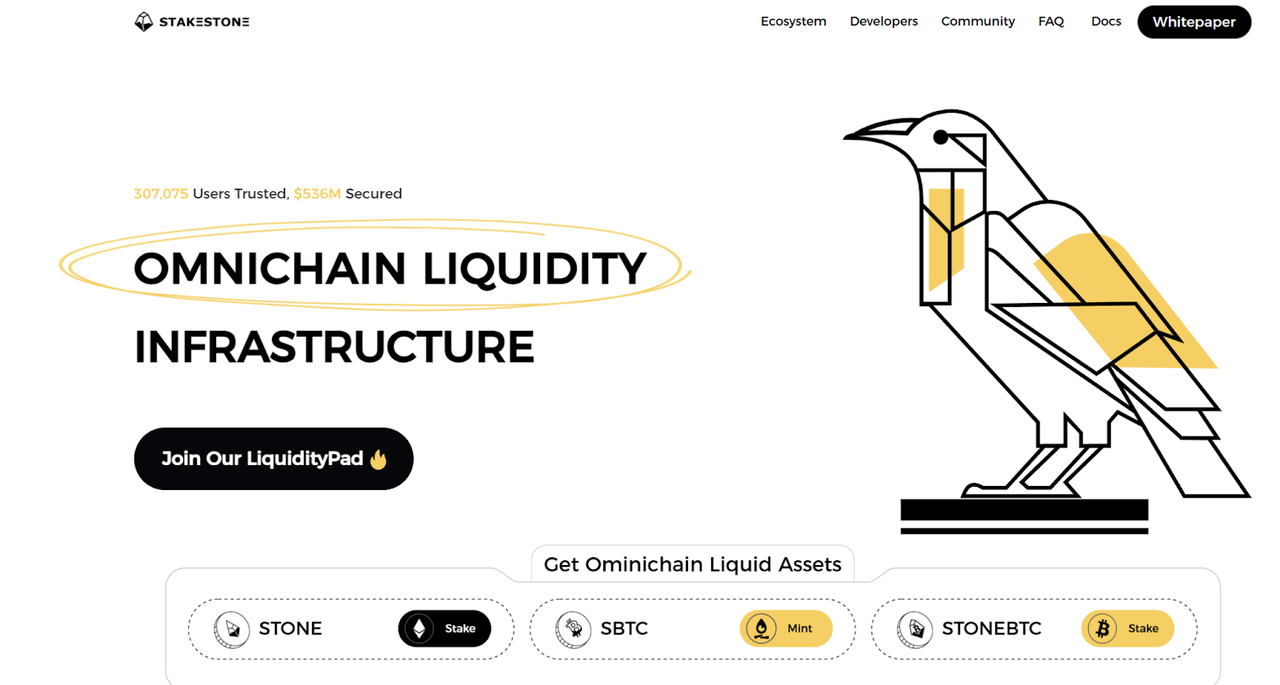
Coin-related
Price calculator
Price history
Price prediction
Technical analysis
Coin buying guide
Crypto category
Profit calculator

StakeStone priceSTO
Key data of StakeStone
Price of StakeStone today
What is the highest price of STO?
What is the lowest price of STO?
StakeStone price prediction
When is a good time to buy STO? Should I buy or sell STO now?
What will the price of STO be in 2026?
What will the price of STO be in 2031?
StakeStone market
StakeStone holdings by concentration
StakeStone addresses by time held

StakeStone ratings
About StakeStone (STO)
What Is StakeStone (STO)?
StakeStone is a decentralized omnichain liquidity infrastructure protocol designed to solve liquidity fragmentation in the cryptocurrency and decentralized finance (DeFi) space. Founded in 2023 by Charles K, it focuses on enabling seamless liquidity across various blockchain networks, with a particular emphasis on Ethereum (ETH) and Bitcoin (BTC). StakeStone aims to offer a solution for users who want to participate in staking while keeping their assets liquid and flexible for other DeFi applications.
The protocol introduces three primary assets: STONE, SBTC, and STONEBTC. These tokens are designed to allow users to stake their ETH or BTC and earn yields while still maintaining the ability to trade, lend, or provide liquidity in decentralized exchanges (DEXs) and other DeFi platforms. Unlike traditional staking models, StakeStone ensures that assets do not need to be locked for extended periods, making it easier for users to manage their funds while still earning passive income.
By providing a cross-chain liquidity solution, StakeStone allows users to move their assets across different blockchain networks. This helps eliminate barriers that currently exist in liquidity provision across isolated blockchain ecosystems. StakeStone’s infrastructure provides a more interconnected and efficient liquidity layer, which is particularly important as the DeFi sector continues to grow and diversify.
How StakeStone Works
1. Liquid Staking for ETH (STONE)
Users can stake their Ethereum (ETH) on the StakeStone platform and receive STONE, a token that represents their staked ETH. Unlike traditional staking, STONE allows users to continue using their assets in decentralized exchanges (DEXs), lending platforms, or liquidity pools while earning staking rewards.
2. Liquid BTC with SBTC
Similar to ETH, users can convert their Bitcoin (BTC) into SBTC, a liquid version of BTC. SBTC allows users to access the benefits of holding BTC while providing them with the flexibility to trade or lend it across various blockchain networks, enhancing liquidity.
3. Yield-Bearing BTC with STONEBTC
STONEBTC is a yield-bearing derivative of Bitcoin that enables BTC holders to earn rewards while keeping their assets liquid. STONEBTC integrates advanced DeFi strategies to generate sustainable yields, providing a seamless way for users to participate in yield generation without sacrificing asset flexibility.
4. Cross-Chain Liquidity
StakeStone facilitates cross-chain liquidity, allowing assets like STONE, SBTC, and STONEBTC to be used across different blockchain ecosystems. This cross-chain functionality ensures users can access the best liquidity options available without being limited to a single chain.
5. Governance with STO
The STO token is StakeStone's governance token, allowing users to participate in protocol decisions. By locking STO into veSTO (vote-locked STO), users gain governance power, enabling them to influence key decisions about the platform’s future, such as liquidity incentives and protocol upgrades.
What Is STO Token?
STO is the governance token of the StakeStone ecosystem, with a total supply of 1 billion tokens. It plays a central role in managing the platform’s decision-making process and incentivizing users. By locking STO tokens, users can mint veSTO, which grants them voting rights on important protocol changes. This model allows token holders to help shape the development of the platform while receiving additional rewards for their participation.
STO holders can use their tokens to participate in governance votes, direct liquidity incentives to specific pools, and influence the overall direction of the protocol. The platform’s use of STO and veSTO helps ensure that decisions are made by the community of token holders, aligning incentives for long-term success.
Should You Invest in StakeStone?
Deciding whether to invest in StakeStone depends on your goals and risk tolerance. While StakeStone presents an innovative approach to liquidity provision and staking, it is important to consider the inherent risks of investing in a decentralized and relatively new platform. As with any DeFi investment, users should conduct thorough research and consider their risk profile before participating.
Conclusion
StakeStone offers a promising solution to the challenges of liquidity and staking in the DeFi space. By providing liquid staking solutions for both ETH and BTC, the platform allows users to earn yields without sacrificing liquidity. Its cross-chain liquidity functionality and governance model provide users with flexibility and control over their investments. However, as with any DeFi protocol, it’s essential to stay informed and consider both the opportunities and risks before getting involved.
Related Articles about StakeStone
StakeStone (STO): Revolutionizing Omnichain Liquidity for ETH and BTC
How to buy StakeStone(STO)

Create Your Free Bitget Account

Verify Your Account

Convert StakeStone to STO
Join STO copy trading by following elite traders.
StakeStone news





Buy more
FAQ
What is the current price of StakeStone?
What is the 24 hour trading volume of StakeStone?
What is the all-time high of StakeStone?
Can I buy StakeStone on Bitget?
Can I get a steady income from investing in StakeStone?
Where can I buy StakeStone with the lowest fee?
Where can I buy StakeStone (STO)?
Video section — quick verification, quick trading

STO resources
Related assets

































